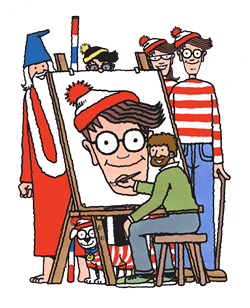
Over the New Year’s break, I had a blast watching JetLag: The Game with my daughter. We binged all of Tag Across Europe as well as the Tom Scott Plus bonus video (UPDATE: and a week into the new year we subscribed to Nebula and watched the prototype season too, Crime Spree). Scroll down to watch on YouTube.
While three days training across Europe looks like fun, it’s a bit much in cost and time to replicate with my own family, which made me ponder a single city version that could be just as intense, just as fun, and replicable by more people.
BTW, what few people know about me is that I’ve been playing serious board games since I was a teenager and I’ve dabbled in game design a few times over the years. For example, see The Next Step: Game for a gamified version of my The Next Step book series.
The Goal
The goal of the game is to gather points. The team with the most points at the end of the day wins. Each team begins with 1000 points. New points are added by going to specific locations (determined by cards from a deck). Points are spent by traveling on a metro/subway. Points are captured by spotting opponents (via photos texted to the group).
Like in JetLag, some players have their location broadcast to the group, and some players don’t. Again like in JetLag, those roles change depending on spotting or being spotted. But unlike JetLag’s TAG, opponents don’t have to physically tag each other.
1. 6 / 9 / 12 / 15 hours
Setup step one, pick a timeframe. The game is played in three thirds, which can be two, three, four, or five hours each, and thus the game is either 6, 9, 12, or 15 hours long.
2. Big City w/ a Metro
Step two, pick a major world city with a large metro/subway system. London, New York, Paris, Berlin, Tokyo, etc. That city and its subways are the game board.
3. Teams of Two
Step three, create teams of two. Ideally at least three teams, but the game will work with just two teams and will be far more exciting and intense as you add more teams.
4. Big, bold colors
Step four, each team picks a distinct color, wearing shirts and hats of that color. For a YouTube production, both team members in striped shirts, with one team member in horizontal stripes and the other in vertical stripes to be distinctive at a distance. E.g. for a red team, one person should look like distinctly like Where’s Waldo at 100m and the other should look like Waldo turned 90°.
5. Hunters & Gatherers
Pick one member of the team to be a hunter and the other as a gatherer. Don’t fret, the roles will likely change during the game play.
6. Dice and Decks
Every player has an identical deck of cards, numbered from 1 through 18. Each card has a destination in the city. In the first third of the game, the gatherers roll three dice and pick that numbered card from the deck. The gatherer’s job is to go to that destination.
Actually, each player has three decks, one for each third of the game. Deck A has 18 cards. Deck B has 12 cards. Deck C has just 6 cards. In each third of the game, one fewer dice are used, and thus there are fewer destinations, and thus the potential destinations get smaller as the game progresses.
Each card can be used by a given player only once, so if they roll a number they’ve rolled before, the gatherer instead pulls a card from a fourth deck, which contains cursed cards like in the JetLag: TAG game that force the gatherer to waste time.
7. Navigating the City
The gatherers must only use the metro and walking to reach the chosen destination. No taxis. No ride share. No scooters. No bicycles. Ideally just subways and trams.
The trick is that after picking a card, the gatherer can only use each metro line once, can not change metro lines within a single station, and can not switch stations underground. This forces the gatherer above ground, making them easier to spot. (Ideally each card has a list of metro lines so the gathers can cross them off as they ride, as well a space to record the number of stops ridden to help tally points at the end of the game.)
Meanwhile, it costs points to ride a metro. 10 points per stop in the first third of the game, 15 points per stop in the second third, and 25 points per stop in the final third. This prevents a gatherer from spending the day crossing the city without making any progress toward gathering.
And to push that incentive further, no gatherer can stay in one location for more than five minutes.
8. Points!
When a gatherer reaches a rolled destination, the card includes a link to a poem, monologue, or other passage they must read aloud. The destinations are all highly visible locations, e.g. the entrance to a famous building or a large, public statue.
The gatherer must recite the text of that destination, aloud, before being spotted. The text is chosen to take 1-2 minutes to recite. Upon completion, without being spotted, the gatherer gains 1,000 points.
The gatherer then has to rolling for a new destination before moving on, keeping them visible to hunters.
9. Hunting
The hunters job is to spot gatherers from other teams. All gatherers locations are known to all hunters, making this easier. Hunters locations are not shared. Hunters spend no points to ride metros and have no limits on how many metro lines they can ride.
When a hunter takes a selfie with the gatherer in view, (s)he texts the picture to the group as proof.
When a hunter successfully spots a gatherer, (s)he earns half of that gatherer’s current points, plus 100 points to create asymmetry, and the roles swap. The hunter becomes a gatherer and rolls dice for her/his destination. The gatherer becomes a hunter, loses the right to ever visit the rolled destination, and has to wait five minutes before starting to hunt.
While hunting, if a hunter spots a hunter from another team, texting a picture freezes the spotted hunter for two minutes. No points are swapped. A hunter can not then spot the same hunter again before spotting another player.
If a hunter spots both team members from another team, and manages to take a selfie with both of the opponents visible, that hunter receives half of the points from the whole team, whether that team is all hunters or all gathers or a mix. If either member of the spotted team is a gatherer, the successful hunter becomes a gatherer. If both members of the spotted team are gatherers, the person who has been the gatherer the longest becomes a hunter.
10. Teamwork
When two team members meet up face-to-face, they can swap points. Team member can text each other, but no phone voice calls are allowed during the game. No “operators” or others outside the game can help players.
Playability
All major metro systems include an unlimited day pass, thus making this game far more reasonable in terms of cost than anything on Jet Lag. The only materials needed are some colorful t-shirts and a deck of cards (which could be all blank cards with hand written destinations).
Personally, I’d love to see Jet Lag branded card decks for New York, London, and Paris, sold by the team as a way to help pay for them to do what they do. Sam, Adam, and Ben, if you ever do read this I’m happy to use by Illustrator skills and GameCrafter.com knowledge to help you make that a reality.











